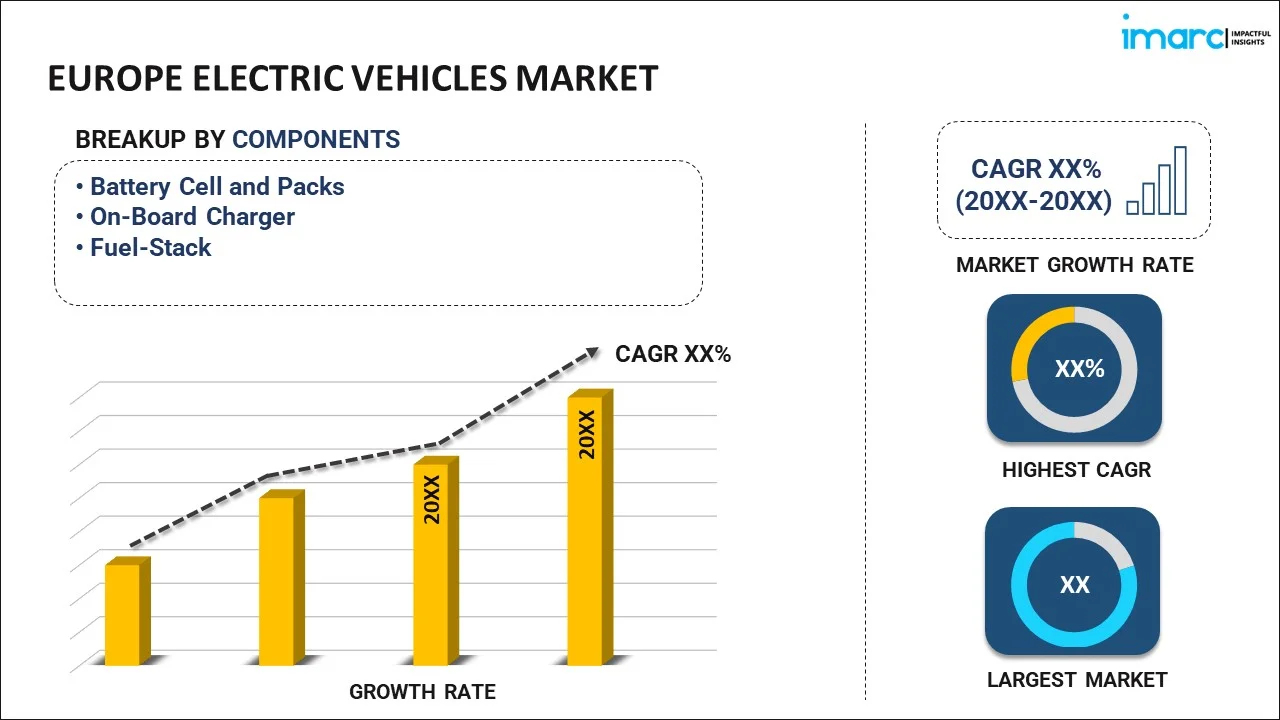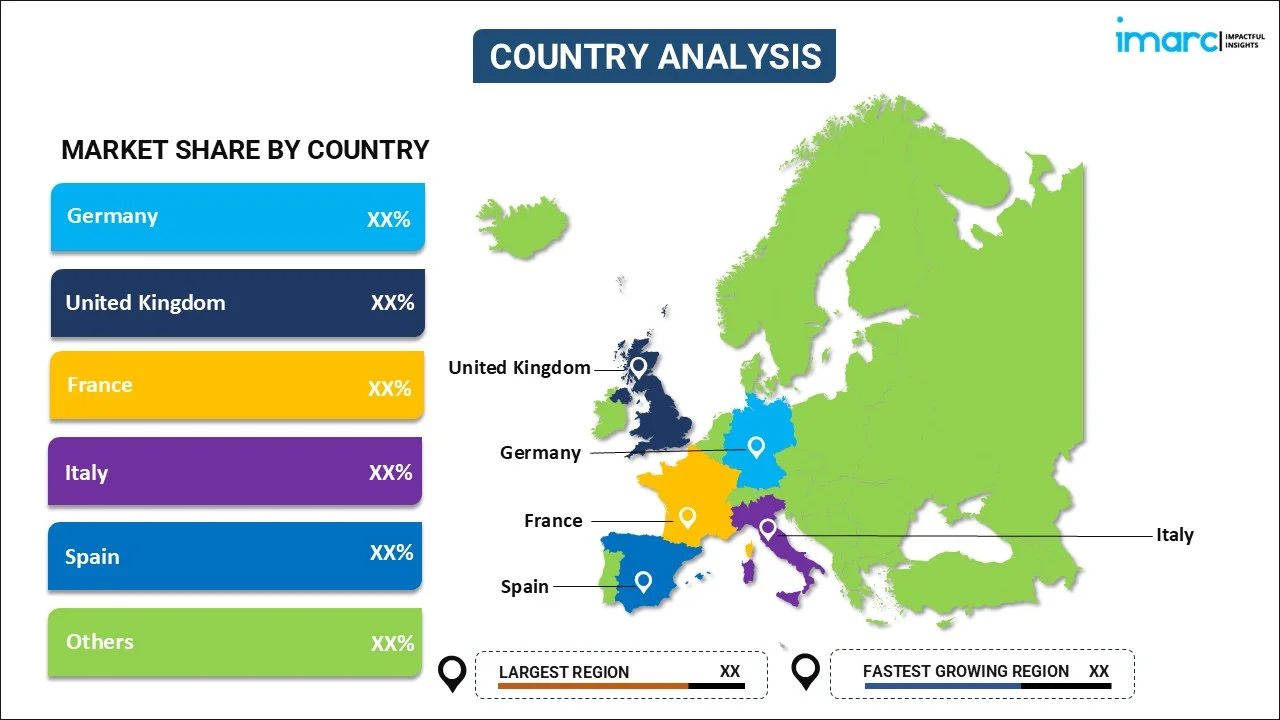
Europe Electric Vehicles Market Report by Component (Battery Cell and Packs, On-Board Charger, Fuel-Stack), Charging Type (Slow Charging, Fast Charging), Propulsion Type (Battery Electric Vehicle (BEV), Fuel Cell Electric Vehicle (FCEV), Plug-In Hybrid Vehicle (PHEV), Hybrid Electric Vehicle (HEV)), Vehicle Type (Passenger Vehicles, Commercial Vehicles, and Others), and Country 2025-2033
Europe Electric Vehicles Market Overview:
The Europe electric vehicles market size reached USD 256.7 Billion in 2024. Looking forward, IMARC Group expects the market to reach USD 1,156.2 Billion by 2033, exhibiting a growth rate (CAGR) of 17.30% during 2025-2033. The increasing government support and incentives, stringent emission regulations, advancements in battery technology, rising awareness about environmental concerns and changing consumer attitudes, rapid urbanization and air quality concerns, and significant technological innovation and investment contribute to the Europe electric vehicles market share. Morgan Stanley forecasts that battery electric vehicles could account for more than half of the market by 2030, with sales possibly climbing to around 7.5 Million Units.
|
Report Attribute
|
Key Statistics
|
|---|---|
|
Base Year
|
2024
|
|
Forecast Years
|
2025-2033
|
|
Historical Years
|
2019-2024
|
|
Market Size in 2024
|
USD 256.7 Billion |
|
Market Forecast in 2033
|
USD 1,156.2 Billion |
| Market Growth Rate 2025-2033 | 17.30% |
An electric vehicle (EV) is an automobile powered by electricity, utilizing one or more electric motors for propulsion instead of traditional internal combustion engines that rely on fossil fuels. These cutting-edge vehicles have gained substantial popularity in recent years due to their environmental benefits, improved technology, and increased accessibility. Electric vehicles operate on the principle of storing electrical energy in rechargeable batteries, which power the electric motor to generate the necessary torque and rotation for movement. The elimination of tailpipe emissions makes EVs significantly more environment-friendly than their gasoline-powered counterparts, contributing to reduced air pollution and a decreased carbon footprint. The range of electric vehicles varies depending on battery capacity and advancements in battery technology, however it has been steadily improving, making them more practical for everyday use. Charging infrastructure is also expanding rapidly, with numerous charging stations becoming available in urban areas, making it easier for EV owners to recharge their vehicles. Besides the environmental advantages, electric vehicles also offer lower operating costs due to the reduced reliance on expensive fossil fuels and simplified maintenance, as they have fewer moving parts than traditional vehicles. As governments and societies worldwide prioritize sustainability and seek ways to combat climate change, electric vehicles play a crucial role in shaping a cleaner and more sustainable transportation landscape for the future.
Europe Electric Vehicles Market Trends:
Stricter Emission Standards and Policy Support
European regulators are steadily pushing for cleaner transportation through strict emission limits and favorable policies. Countries across the region are phasing out internal combustion engine vehicles by setting future bans and promoting zero-emission alternatives. Tax reductions, purchase subsidies, and grants for charging infrastructure are encouraging faster adoption of electric vehicles among individuals and businesses. The EU electric vehicle market is strongly influenced by the European Union’s Green Deal and climate goals. This pressure, paired with incentives, is reshaping the Europe hybrid electric vehicle market as hybrids remain relevant for buyers seeking a transitional step toward full electrification.
Shift toward Electric Corporate Fleets
Large companies in Europe are transitioning their vehicle fleets to electric as part of sustainability commitments and cost management strategies. Fleet electrification is gaining traction in logistics, ride-hailing, delivery services, and corporate mobility programs. Businesses benefit from lower operating costs, exemption from emission-based taxes, and compliance with corporate social responsibility goals. Additionally, expanding charging networks and vehicle options make it easier for organizations to replace conventional fleets. These efforts reflect wider European EV market trends, where corporations are shaping large-scale demand. Together, they also strengthen the Europe electric car market, with bulk orders and partnerships driving higher adoption rates.
Falling Battery Prices and Technology Breakthroughs
The cost of EV batteries has been declining steadily, making electric vehicles more affordable for the mass market in Europe. Improvements in energy density, faster charging capability, and extended driving range are addressing consumer concerns around convenience and usability. Solid-state batteries, lightweight materials, and better power electronics promise even greater efficiency. Meanwhile, localized manufacturing and economies of scale are reducing costs. Automakers are now offering models across different price segments, accelerating mass adoption of EV in Europe. With affordability improving and technology advancing rapidly, electric mobility is set to dominate the region’s transportation future.
Europe Electric Vehicles Market Segmentation:
IMARC Group provides an analysis of the key trends in each segment of the Europe electric vehicles market report, along with forecasts at the regional and country levels for 2025-2033. Our report has categorized the market based on component, charging type, propulsion type, and vehicle type.
Component Insights:

To get more information on this market, Request Sample
- Battery cells and packs
- On-board charger
- Fuel stack
The report has provided a detailed breakup and analysis of the market based on the component This includes battery cell and packs, on-board charger, and fuel-stack.
Charging Type Insights:
- Slow charging
- Fast charging
A detailed breakup and analysis of the market based on the charging type has also been provided in the report. This includes slow charging and fast charging.
Propulsion Type Insights:
- Battery electric vehicle (BEV)
- Fuel cell electric vehicle (FCEV)
- Plug-in hybrid vehicle (PHEV)
- Hybrid electric vehicle (HEV)
The report has provided a detailed breakup and analysis of the market based on the propulsion type This includes battery electric vehicle (BEV), fuel cell electric vehicle (FCEV), plug-in hybrid vehicle (PHEV), and hybrid electric vehicle (HEV).
Vehicle Type Insights:
- Passenger vehicles
- Commercial vehicles
- Others
A detailed breakup and analysis of the market based on the vehicle type has also been provided in the report. This includes passenger vehicles, commercial vehicles, and others.
Country Insights:

- Germany
- France
- United Kingdom
- Italy
- Spain
- Others
The report has also provided a comprehensive analysis of all the major regional markets, which include Germany, France, United Kingdom, Italy, Spain, and others.
Competitive Landscape:
The report has also provided a comprehensive analysis of the competitive landscape in the Europe electric vehicles market. Competitive analysis such as market structure, key player positioning, top winning strategies, competitive dashboard, and company evaluation quadrant has been covered in the report. Also, detailed profiles of all major companies have been provided, including:
- Audi AG
- Bayerische Motoren Werke AG
- Groupe Renault
- Hyundai Motor Company
- Kia Corporation
- Mercedes-Benz
- Tesla Inc.
- Toyota Motor Corporation
- Volvo Car AB
- Volkswagen AG
Europe Electric Vehicles Market News:
- In August 2025, reports suggested that Western Europe recorded nearly 600,000 new battery-electric vehicle registrations in the second quarter, the highest on record. Affordable models from Renault and Stellantis, coupled with wider charging access, drew private buyers in large numbers. Growth is forecast to extend into Q3, boosted by UK plate renewals, revived French leasing schemes, and government subsidies, though premium EVs like Tesla may see slower demand.
- In April 2025, Europe’s electric vehicle market hit a turning point as BYD surpassed Tesla in pure EV registrations for the first time. Battery electric sales climbed 28% and plug-in hybrids 31%. Overall passenger car registrations across 28 European nations stayed steady, with 1,078,521 units in April and 4,467,681 year-to-date.
Europe Electric Vehicles Market Report Coverage:
| Report Features | Details |
|---|---|
| Base Year of the Analysis | 2024 |
| Historical Period | 2019-2024 |
| Forecast Period | 2025-2033 |
| Units | Billion USD |
| Scope of the Report | Exploration of Historical and Forecast Trends, Industry Catalysts and Challenges, Segment-Wise Historical and Predictive Market Assessment:
|
| Components Covered | Battery Cell and Packs, On-Board Charger, Fuel-Stack |
| Charging Types Covered | Slow Charging, Fast Charging |
| Propulsion Types Covered | Battery Electric Vehicle (BEV), Fuel Cell Electric Vehicle (FCEV), Plug-In Hybrid Vehicle (PHEV), Hybrid Electric Vehicle (HEV) |
| Vehicle Types Covered | Passenger Vehicles, Commercial Vehicles, Others |
| Countries Covered | Germany, France, United Kingdom, Italy, Spain, Others |
| Companies Covered | Audi AG, Bayerische Motoren Werke AG, Groupe Renault, Hyundai Motor Company, Kia Corporation, Mercedes-Benz, Tesla Inc., Toyota Motor Corporation, Volvo Car AB, Volkswagen AG, etc. |
| Customization Scope | 10% Free Customization |
| Post-Sale Analyst Support | 10-12 Weeks |
| Delivery Format | PDF and Excel through Email (We can also provide the editable version of the report in PPT/Word format on special request) |
Key Benefits for Stakeholders:
- IMARC’s report offers a comprehensive quantitative analysis of various market segments, historical and current market trends, market forecasts, and dynamics of the Europe electric vehicles market from 2019-2033.
- The research study provides the latest information on the market drivers, challenges, and opportunities in the Europe electric vehicles market.
- Porter's five forces analysis assist stakeholders in assessing the impact of new entrants, competitive rivalry, supplier power, buyer power, and the threat of substitution. It helps stakeholders to analyze the level of competition within the Europe electric vehicles industry and its attractiveness.
- Competitive landscape allows stakeholders to understand their competitive environment and provides an insight into the current positions of key players in the market.
Key Questions Answered in This Report
The electric vehicles market in Europe reached USD 256.7 Billion in 2024.
The Europe electric vehicles market is projected to exhibit a CAGR of 17.30% during 2025-2033, reaching USD 1,156.2 Billion by 2033.
The Europe electric vehicles market is driven by strong government incentives, strict emission regulations, rising fuel costs, and growing environmental awareness. Expansion of charging infrastructure, advancements in battery technology, and commitments to phase out combustion engines by countries further accelerate adoption, supported by investments from major automakers.
Need more help?
- Speak to our experienced analysts for insights on the current market scenarios.
- Include additional segments and countries to customize the report as per your requirement.
- Gain an unparalleled competitive advantage in your domain by understanding how to utilize the report and positively impacting your operations and revenue.
- For further assistance, please connect with our analysts.
 Request Customization
Request Customization
 Speak to an Analyst
Speak to an Analyst
 Request Brochure
Request Brochure
 Inquire Before Buying
Inquire Before Buying




.webp)




.webp)












